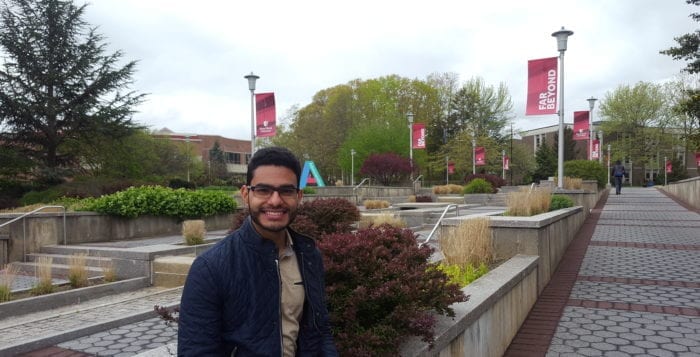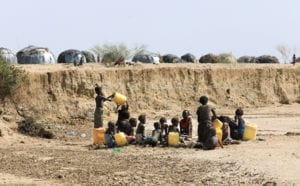SBU Undergrad engineers see opportunities to learn and help in Kenya

By Daniel Dunaief
In a region known for the study of fossils left behind millions of years ago, a team of students from Stony Brook University’s College of Engineering and Applied Sciences is planning to travel to Kenya this summer to learn about and try to solve the challenges of today.
The university will send eight undergraduates to the Turkana Basin Institute for the engineering department’s first program in Kenya, which will run for over four weeks. In addition to classroom study, the students will seek opportunities to offer solutions to problems ranging from refrigeration, to energy production, to water purification.
The students learned about the opportunity in the spring, only a few months before they would travel to a country where the climate and standard of living for Kenyans present new challenges. “We were skeptical about how many students we would be able to get,” said Fotis Sotiropoulos, the dean of the College of Engineering and Applied Sciences, who “didn’t start marketing this” until after he took a trip to Kenya and the Turkana Basin Institute, which Stony Brook created at the direction of world-renowned anthropologist Richard Leakey.
Giancarlos Llanos Romero, who is interested in robotics and nanotechnology and is finishing his junior year, had originally planned to spend the summer seeking an internship in the Netherlands or Germany. When he learned about this opportunity, he immediately changed his focus. “I need to do this,” Romero said. “This is much more important than anything I could do in an internship.”
On first blush, the trip is anything but ideal for Romero, whose skin is sensitive to extreme heat, which he can expect to encounter in the sub-Saharan African country. He didn’t want that, however, to stop him and is planning to travel with seven other people he met for the first time last week. Romero said his immediate family, which is originally from Colombia, supported the trip.
Sotiropoulos, who is in his first year as dean, embraced the notion of connecting the engineering department with the Turkana Basin Institute. “Before I came here” said Sotiropoulos, “I felt very passionately about making sure that engineering students became familiar with the rest of the world” and that they understood global challenges, including issues like poverty and water scarcity.
Sotiropoulos met with TBI Director Lawrence Martin during one of his interviews prior to his arrival at SBU. Martin invited Sotiropoulos to visit with Richard Leakey, the founder of TBI whose family has been making scientific discoveries in Kenya for three generations.

This program quickly came together after those meetings. The two courses will teach students about design thinking, said Robert Kukta, the associate dean for undergraduate programs in the College of Engineering and Applied Sciences. Stony Brook would like to help students develop “the ability to think broadly about solutions and boil it down to the essence of the problem,” Kukta said. This, he said, will all occur in the context of a different culture and local resources.
Students will start their summer experience in Nairobi and then they will travel to Princeton University’s Mpala Research Centre, Martin said. “The journey through Kenyan towns opens visitors’ eyes tremendously to how different peoples’ lives are in different parts of the world,” Martin explained by email. “The goal is not so much to contribute immediately but to understand the challenges that people face, the resources available locally and then to improve their ability to think through possible solutions.”
Once students arrive at TBI, they will have an opportunity to see fossils from many time periods, including those from late Cretaceous dinosaurs. “Every visitor I have ever taken to TBI is amazed and in awe of the abundance of fossil evidence for past life on Earth,” Martin said.
A distinguished professor in the Department of Chemistry at SBU, Benjamin Hsiao, who traveled with Sotiropoulos to Kenya in the spring, is a co-founding director of Innovative Global Energy Solutions Center. Hsiao has been developing water filtration systems through IGESC, which brings together TBI with universities, industry, international governments and foundations. He is well acquainted with the challenges the first set of students will face.
“Once we bring technologies over to Kenya, [sometimes] they do not work for reasons we have not thought of,” which include dust or a broken part for which it’s difficult to find a replacement, he said. “Those failed experiments give us tremendous insight about how to design the next-generation systems which will be much more robust and sustainable and easier to operate by local people.”
Acacia Leakey, who grew up in Kenya and is Richard Leakey’s grandniece, recently completed her senior design project as an undergraduate at Stony Brook. Her work is intended to help farmers extend the life of their tomato plants when they bring them to market.
About 32 percent of the tomatoes go to waste from the extreme heat. Acacia and her team developed a vegetable cooler that employs solar panels to reduce the temperature from 32 degrees Celsius to 15 degrees Celsius, which should extend the life of the tomatoes. Her classmates were “surprisingly supportive” of her work, she said, as some of them hadn’t considered applying their skills in a developing country.
Leakey, who will train for her master’s degree at Stony Brook this fall, will continue to provide insights into Madagascar, another developing African nation where the university has an internationally acclaimed research center. This summer, she will produce a video that will record information from villages near Centre ValBio in Madagascar, which she will bring back to Stony Brook in the hopes of encouraging others to use that information to create their own design projects next year.
As for Romero, who is raising money for the trip through a GoFundMe page, he is prepared to discover opportunities amid the challenges of his upcoming trip and is eager “to be able to actually help a community and say I left a mark.”





